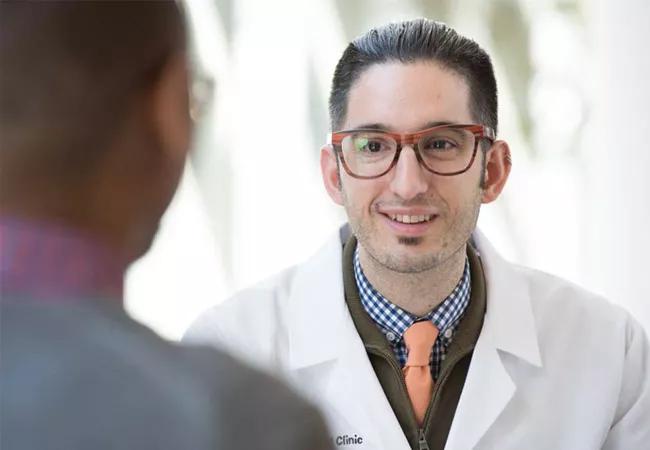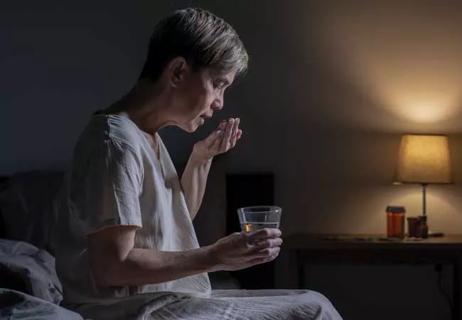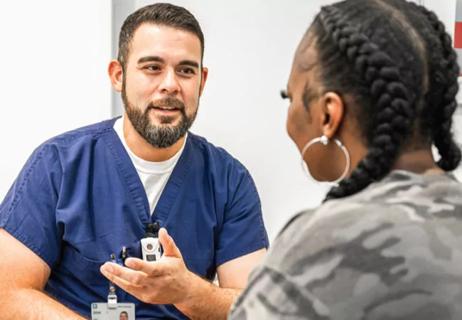Advertisement
A conversation with child and adolescent psychiatrist Jason Lambrese, MD

As a student at the Alpert Medical School of Brown University, Jason Lambrese, MD, realized there wasn’t much education provided on the specific needs of the lesbian, gay, bisexual, transgender, questioning (LGBTQ) community. So once he decided on a career in child and adolescent psychiatry, Dr. Lambrese (shown with a patient above) opted to specialize in the mental health needs of LGBTQ adolescents and educate his peers on behavioral health management of this population.
Advertisement
Cleveland Clinic is a non-profit academic medical center. Advertising on our site helps support our mission. We do not endorse non-Cleveland Clinic products or services. Policy
Consult QD sat down with Dr. Lambrese — who joined Cleveland Clinic in September 2017 and will be based out of the Center for LGBT Care at Cleveland Clinic’s new Lakewood Family Health Center when it opens later this year — to discuss improving behavioral health care for LGBTQ youth.
Q: What are the primary mental health issues among LGBTQ youth?
A: The biggest concern is a disproportionate level of depression, suicidal ideation and suicide attempts in LGBTQ adolescents compared with non-LGBTQ adolescents. There are a lot of reasons why those levels are higher. I don’t think it’s something innate in being LGBTQ that puts someone at risk. Instead, there’s often a societal and cultural piece to this. There are issues with victimization, discrimination, bullying and ostracism in schools, in the community and online. Unfortunately, for some kids these problems extend into their home, too.
Q: How might management of this population differ from behavioral health management of other youth?
A: It’s about recognizing the specific risk factors — thinking about the struggles around sexual orientation or gender identity that might be part of the patient presentation. This is especially important with risk assessments. If someone is presenting suicidal or they are in distress, look at the risk factors.
Advertisement
Another thing is to ask the same very general questions to all our patients to make sure we’re identifying kids at risk when sexual orientation or gender identity is part of the picture. We don’t have to ask, “Are you L, are you G, are you B?” We can ask, “Who are you dating, who are you interested in, who do you have a crush on?” These are very general questions we can ask all our patients that will give us helpful information about sexual identity.
The other really important aspect is thinking about the family piece. The family contribution to mental health can be huge for all young people, but we see that the family piece is particularly important for LGBTQ youth in terms of providing a protective factor. The more the family is supportive of what the kid is going through, the lower their risk. When these kids are rejected by their families, we see their risk of depression and suicide go up manyfold.
Q: What new offerings are you bringing to Cleveland Clinic as part of the Center for LGBT Care?
A: We really want to increase the level of support for young people in a safe and affirming space. All of us see LGBTQ patients, and many of us provide safe spaces. But these teenagers don’t know that, so they are very anxious and worried about coming into a healthcare environment. What’s this healthcare provider going to ask me? Are they going to listen to me? Are they going to judge me? Coming into a space that’s identified as an LGBTQ center takes away some of that fear.
I’ll be doing general outpatient mental healthcare for children and teenagers, offering an option for those who need a psychiatrist for depression or anxiety or ADHD but who want that psychiatrist to be part of this safe and affirming space. I’ll also do work with the transgender population, conducting mental health assessments in terms of readiness for hormone therapy and transition. I also hope to add group sessions. It’s great to have groups available for these young people where they can meet others going through similar struggles.
Advertisement
Q: Are the behavioral health needs of LGBTQ youth being adequately met in the U.S.?
A: We’re getting there, but we’re not there quite yet. There’s still anxiety on the part of providers who don’t know how to handle LGBTQ patients, don’t know what resources are available or don’t know what the treatment options are if someone thinks they are transgender. I’m hoping our center can offer professional development to other providers and education to trainees so we can prepare the next generation of providers to think about the needs of LGBTQ youth from the beginning.
Q: What insights can you share with behavioral health colleagues around the country?
A: The first thing is that it’s OK to ask young people about their sexual orientation and gender identity. In fact, patients expect us to ask. Studies find that the anxiety around these questions is much greater on the provider end than the patient end. The onus is on us as providers to ask the questions. It’s also OK if patients don’t come out to you right away. We’re just opening the door and starting the conversation in a safe space.
Providers also need to know the resources in their community: What’s out there? What are the resources where kids can meet other LGBTQ kids? Are there groups at school? Being able to link up these kids with other services is important.
In addition, make your office space as accepting as possible. There are simple things we all can do. Have affirming information in the waiting room, like a flier about LGBTQ community resources or a magazine with an LGBTQ focus. Maybe it’s as simple as a rainbow sticker on the door. Try to offer some visual cue that says this is a safe space.
Advertisement
Advertisement

Multidisciplinary program helps budding clinicians explore the human dimensions of patient care and medical research

Program empowers Black stylists to provide emotional first aid

Positive emotions, low impulsivity appear to safeguard against weight gain, other comorbidities

Consultation service provides comprehensive care to patients with anxiety, PTSD, schizophrenia, and other high-risk disorders

Study shows a growing openness to the clinical potential of psychedelic treatments

Urine test strips and point-of-care testing may be key to slowing opioid epidemic

Study sheds light on how clinicians addressed their patients’ pain and insomnia during the pandemic

Recovery's in Reach provides treatment options, peer support to those struggling with alcohol and drug use